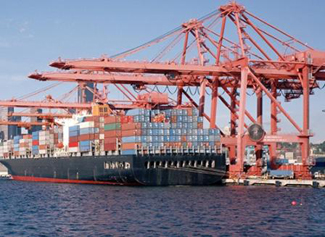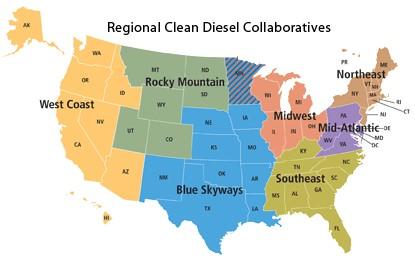Ports Primer: 7.3 Federal Environmental Regulations and Programs
The mission of EPA is to protect human health and the environment. EPA is responsible for establishing regulations and standards for key environmental statutes affecting ports as well as complementary grant and voluntary programs. While there is a broad range of environmental regulations that applies to ports depending on the circumstance, those with regulations and initiatives with particular relevance to near-port communities include:
- Clean Air Act (CAA)
- Clean Water Act (CWA) and the proposed Waters of the United States rule
- National Environmental Policy Act (NEPA)
- Ports Initiative
Clean Air Act (CAA)
The CAA is designed to protect public health and welfare from different types of air pollution. It establishes air quality standards and requires states to develop enforceable plans to achieve those standards. For the port industry, significant aspects of the CAA include regulations on diesel engines, marine vessel loading operations, paint coatings, and emissions from vehicles and many types of port equipment.
Many of the vehicles and equipment involved in port activities remain in operation for a long time. Often referred to as the legacy fleet, these diesel vehicles and equipment are not regulated by EPA under the CAA. EPA’s regulatory authority only reaches the ability to regulate emissions from new vehicles and equipment. Unlike EPA, California may regulate emissions from legacy fleets directly (e.g., nonroad diesel in-use fleet requirements) if it receives authorization from EPA, and other states might choose to adopt California’ standards (if certain criteria are met). Similarly, California has regulated (with authorization from EPA) the manufacture of new vehicles and equipment that may be found in port operations (e.g., new mobile cargo handling equipment, new shore power equipment, etc.). In addition, in some instances states are able to regulate the use and hours of operation of the legacy fleet.
For more information:
Clean Water Act (CWA) and the Waters of the United States
The CWA regulates the discharge of pollutants into navigable waters and regulates surface water quality. The CWA made it illegal to discharge any pollutant into navigable waters without a permit from EPA’s National Pollutant Discharge Elimination System (NPDES) permit program.
Understanding what waters are covered by the CWA can be complex. EPA, the Department of Army, and the Army Corps of Engineers (USACE) have repealed the 2015 Clean Water Rule defining Waters of the United States (WOTUS) and re-codified the regulatory text that existed prior to the 2015 Rule. The Navigable Waters Protection Rule has been proposed, and when final will list four categories of waters that will be federally regulated. More information on the Navigable Waters Protection Rule is available on the Rulemaking website.
For more information:
- National Pollutant Discharge Elimination System
- Port Compliance: Federal Regulations Exit
- Clean Water Act
- Navigable Waters Protection Rule Rulemaking Process
- Frequently Asked Questions - Navigable Waters Protection Rule
National Environmental Policy Act (NEPA)
NEPA, which was enacted in 1970, requires federal agencies to analyze the environmental impacts of federal construction projects, permit approvals, and funding decisions and to consider reasonable alternatives to those actions. NEPA is intended to foster informed decision-making and provide transparency about a proposed action’s environmental consequences. NEPA includes a requirement for consideration of community mitigation plans where appropriate.
Once NEPA regulations are triggered, the lead federal agency is required to conduct an environmental impact statement (EIS) for actions that may have a significant impact on human health and the environment, or a more succinct environmental assessment (EA). Members of the public can also request that a health impact assessment (HIA) be performed. Types of impacts and issues addressed in these studies can include:1
- Air quality
- Traffic
- Noise and vibration
- Aesthetics
- Environmental justice
- Socioeconomics
- Marine water quality
- Geology, groundwater and soils
- Global climate change
- Land use
- Endangered or threatened species and habitats
- Cultural or historic resources
- Public safety/public services
- Utilities and service systems
- Hazards and hazardous materials
Members of the public can participate in the NEPA process during public comment periods, as well as throughout the entire NEPA process. This makes NEPA an important avenue for near-port communities and environmental advocates.
For more information:
- NEPA
- Environmental Justice Considerations in the NEPA Process
- Defend Your Air (PDF) (68 pp, 5.5 MB, About PDF) Exit
- NEPAssist
- CEQ’s Citizens Guide to NEPA
- CEQ’s Environmental Justice Guidance under the National Environmental Policy Act (PDF) (40 pp, 2.2 MB, About PDF)
- EPA’s Final Guidance for Incorporating Environmental Justice in EPA’s NEPA Compliance
- Promising Practices for EJ Methodologies in NEPA Reviews (56 pp, 895 K, About PDF)
- EJ Screen
EPA Ports Initiative

The EPA Ports Initiative vision is that “People living and working near ports across the country will breathe cleaner air and live better lives as a result of bold steps taken through a collaboration of industry, government and communities to improve environmental performance and increase economic prosperity.” The long-term Ports Initiative goal is for U.S. ports to become global leaders in clean, efficient freight and passenger transportation. Ongoing actions outlined in the initiative elements below are laying the groundwork for achieving both the long-term goal and the vision.
- Funding - Helping Ports Capitalize on Funding for Clean Technologies
- Technical Resources - Providing Tools to Help Identify Smart Infrastructure Investments
- Collaboration - Promoting Port-Community Collaboration for Effective Planning
- Coordination - Increasing Efficiency in Federal Government and Port Operations
- Communications - Creating a Knowledge Clearinghouse
The initiative’s website provides resources on funding opportunities, webinars and stakeholder meetings.
For more information: EPA Ports Initiative
Cleaner Fuel and Cleaner Equipment Available
All communities across the country benefit from EPA regulations requiring manufacturers to produce cleaner diesel fuel and cleaner diesel engines. These include introduction of low-sulfur fuel and requirements for new engines to emit less pollution. Details of proposed and final rules are available in the Additional Information on Federal Environmental Regulations section below.
Together these programs yield enormous long-term benefits for public health and the environment. By 2030, when the engine fleet has been fully turned over, particulate matter (PM) and nitrous oxides (NOx) will be reduced by 380,000 tons/year and 7 million tons/year, respectively. This will result in annual benefits of over $290 billion, at a cost of approximately $15 billion.
 For Regional Contacts, click the map.For more information: EPA Emission Standards for Nonroad Engines and Vehicles
For Regional Contacts, click the map.For more information: EPA Emission Standards for Nonroad Engines and Vehicles
Diesel Emissions Reduction Act (DERA)
 EPA began awarding clean diesel grants in 2008 under DERA and this program is still ongoing. The program stimulates economic growth and jobs in the diesel vehicle sector, and improves public health by reducing diesel emissions from older engines that are scrapped and replaced with new vehicles, retrofitted or repowered. Eligible diesel vehicles, engines and equipment may include buses, Class 5 – Class 8 heavy-duty highway vehicles, marine engines, locomotives and nonroad engines, equipment or vehicles used in construction, handling of cargo (including at a port or airport), agriculture, mining or energy production (including stationary generators and pumps).
EPA began awarding clean diesel grants in 2008 under DERA and this program is still ongoing. The program stimulates economic growth and jobs in the diesel vehicle sector, and improves public health by reducing diesel emissions from older engines that are scrapped and replaced with new vehicles, retrofitted or repowered. Eligible diesel vehicles, engines and equipment may include buses, Class 5 – Class 8 heavy-duty highway vehicles, marine engines, locomotives and nonroad engines, equipment or vehicles used in construction, handling of cargo (including at a port or airport), agriculture, mining or energy production (including stationary generators and pumps).
Eligible applicants include regional, state, local or tribal agencies, or port authorities, with jurisdiction over transportation or air quality. Nonprofit organizations may apply if they provide pollution reduction or educational services to diesel fleet owners or have, as their principal purpose, the promotion of transportation or air quality.
More Information: DERA Funding
Additional Information on Federal Environmental Regulations
 For a more complete summary of the federal environmental regulations that apply to ports: Port Compliance: Federal Regulations Exit
For a more complete summary of the federal environmental regulations that apply to ports: Port Compliance: Federal Regulations Exit
Portcompliance.org is an online resource developed by the National Center for Manufacturing Sciences (NCMS) and EPA Region 2 with input from industry and federal and state regulatory agencies.2 The tool also contains links to resources on state regulations.











